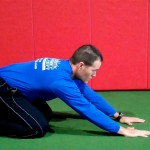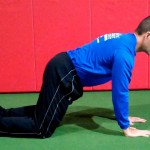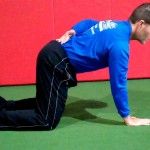Brian Schiff’s Blog
Injury Prevention, Sports Rehab & Performance Training Expert
It is no secret that proper scapula alignment and muscle activation makes for a healthy shoulder. There are many forms of dysfunction that may be present.

Generally speaking problems revolve around muscular tightness/weakness and faulty movement patterns. The term “SICK” scapula is often used and refers to Scapula Inferior Coracoid Dyskinesis. Common examples of a “sick” scapula include:
- Type I – Inferior border prominence. This is typically related to tightness in the pec minor and weakness in the lower trapezius. Keep in mind the upper trapezius will naturally dominate the lower trap in the force couple with the serratus anterior for upward rotation. You may also see increased thoracic kyphosis which will inhibit the normal resting position of the scapula.
- Type II – Medial border prominence. In this case the scapula is internally rotated or protracted and there is liekly weakness present in the rhomboids and middle trapezius. The serratus anterior may also likely be weak with evidence of scapular winging. This position places the humerus in relative internal rotation and increases risk of impingement with arm elevation.
- Type III – Superior border presence. Here the scapula appears elevated in the face of an overactive upper trap and/or levator scapulae. With active arm elevation, you may notice excessive shrugging or superior humeral head migration in light of the imbalance. Again, the lower trapezius is probably weak and being overpowered.
Click here for a great graphic display from the Journal of the American Academy of Orthopaedic Surgeons of how the scapular muscles work collectively as a force couple to promote optimal movement in the shoulder.
In many of the throwers and overhead athletes I see in the clinic, they often exhibit either medial border prominence of inferior border prominence. Additionally, I frequently observe GIRD (glenohumeral internal rotation deficit) values of 20 degrees or higher in those patients who come in with symptomatic shoulders (rotator cuff and/or labral issues). What does this mean?
Well, in a nutshell, it means addressing posterior capsule tightness in the throwing shoulder is important for avoiding internal impingement and SLAP tears. Tightness (or too much GIRD) can increase the load/tension in the late cocking phase of throwing thereby contributing to friction between the cuff and labrum, as well as excessive torsion on the proximal biceps tendon. Any excessive humeral head migration with repetitive throwing is a recipe for injury over time.
Research along with years of observation has taught me that the brain is inherently looking for the most efficient way (aka least effort) to execute movement in life. In addition, it HATES pain just like you and I so it does everything possible to avoid it including ordering the body to perform dysfunctional movement patterns.
After a painful episode, the brain often needs reminded that the body can go back to the proper movement patterns once the pain is gone. However, it often holds that painful memory and may by default lean toward a faulty movement pattern. This protective mode then ends up perpetuating a faulty movement pattern that is no longer necessary nor efficient. Over time, dysfunctional movement patterns can create further stress or harm to other segments in the kinetic chain.
So, I am always seeking ways to stimulate the body to work properly and exercises that facilitate proper neuromuscular patterning are instrumental in my rehab and training. I wanted to share two exercises that I like to utilize in my rehab and training for the shoulder. In particular, I like to employ closed chain activity to stimulate the serratus anterior as well as the other scapular stabilizers.
Below are two exercises I wrote about in my “Functionally Fit” column for PFP magazine. The first exercise shows quadruped rocking. Shirley Sahrmann mentions this in her work, Diagnosis and Treatment of Movement Impairment Syndromes. I began using it after reading her book, and I agree that it works very well for scapular dysfunction. Below is the start and finish position for the quadruped version as well as my own advanced tripod version of the exercise.
- Quadruped start
- Quadruped finish
- Tripod finish
For a complete explanation of the exercise and its application, click here to read the column.
As a follow-up to this exercise, I included an unstable progression I like to employ using the BOSU trainer. I call this the unstable tripod scapular clock. It can be done on the knees or up on the toes. I have included a quick video on this below. Again, I like this exercise for scapular work as well as core stability training.
Click here to read my PFP column on this exercise for the full description, application and regressions. The real beauty of this last exercise is the “big bang for your buck” attributes since it hits shoulder, core and hip stability all at once for those able to work at that level. I hope it works as well for you as it has for me!
Dysfunctional movement is common with shoulder pain and impingement. One dysfunction you may encounter is a downwardly rotated scapula. If upward rotation is limited, a client will display excessive shoulder flexion above 90 degrees when the humerus is in maximal internal rotation. Typically, a person will have minimal flexion beyond 90 degrees if the scapula is moving properly.
Upward rotation of the scapula is the result of a force couple between the upper and lower trap along with the serratus anterior. If any of these muscles are weak, rotation can be limited and overpowered by the rhomboids and levator scapulae muscles (both downward rotators). This pattern of muscle dominance is common.
Additionally, tightness in the rhomboids, levator scapulae, pec minor or latissimus can also restrict normal mobility. It is probably safe to assume stretching of the chest and lats would be helpful, but it is critical to encourage the proper muscle firing patterns in the traps and serratus anterior as well.
Below is a video demonstrating wall slide shrugs. The shrug should be done at or above 90 degrees. You can perform reps at multiple angles or move to end range and perform a series there.
Application: The exercise is designed to encourage upward rotation in a more functional manner as opposed to traditional shrugs with the arms at the side. While I am not opposed to traditional shrugs with little or no weight for basic elevation, this position generally tends to activate the rhomboids and levator scapulae which is not desired given their natural dominance pattern.
The wall slide shrugs should not create any pain or discomfort. However, they may feel awkward particularly if the client has a faulty muscle activation pattern. As muscle tightness resolves and strength improves, clients should gain more mobility and optimal shoulder function.
Shoulder impingement and scapular dysfunction are common issues that plague many clients. Research indicates that certain muscles tend to dominate others while other muscles fatigue easily leading to faulty movement patterns and increasing the risk for impingement. Muscle length and posture are also key factors to consider.
I like to use a mini-band retraction with clients exhibiting excessive scapular abduction. In the video below, you will see a simple, yet effective exercise to address this faulty alignment of the scapula. Keep in mind, you must observe the client or patient from behind with the scapula exposed to properly assess alignment and movement.
This exercise is designed to strengthen the middle trapezius and rhomboids. In addition, it will improve scapular stability. Scapular abduction is usually more evident with elevation from 90-180 degrees as the ratio of scapular movement to glenohumeral movement is 1:1 instead of the normal 1:2 ratio throughout since the scapula is already in an excessively abducted posture at rest.
To read more on the application and exact execution of this exercise, click here to read my column for PFP Magazine.




